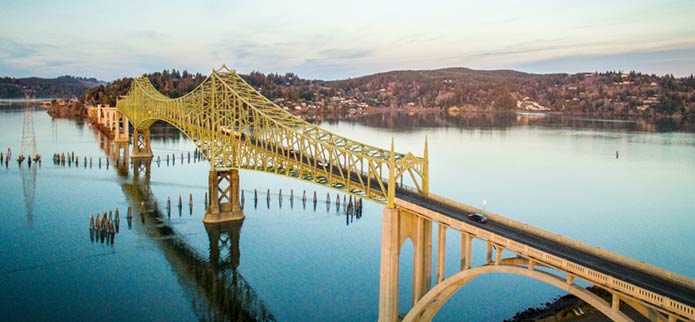Historic Walking Tour of North Bend

- Half day
BRIEF HISTORY OF NORTH BEND
Asa Simpson – sea captain, shipbuilder, lumberman – built a sawmill and shipyard in the mid-1850s at the north bend of the Coos Bay. Most famous of the 55 vessels built here (1858-1903) was the Western Shore, a 3-masted “Oregon clipper” that sailed between Portland and Liverpool in a record time of 101 days in 1876.
Louis Simpson, Asa’s 21-year-old son, took over management in 1899. He purchased the townsite of Yarrow, added it to his father’s lands, and incorporated the City of North Bend in 1903. His goal was to imitate San Francisco.
Isolated by difficult terrain, the citizens relied on the waterways to carry cargo and passengers to points on the bay or sloughs. Ocean-going ships navigated the treacherous Coos Bay bar to access other ports.
Nearly 10,000 citizens now live in “the city that believes in itself.” The future may differ from the past, but North Benders remain proud of their town and history.
Listed below are just a few of our many points of interest.
McCULLOUGH BRIDGE (1936) Last of five coast bridges to complete the Roosevelt Highway (US 101). It was a depression-era WPA project, costing more than $2,000,000, employed hundreds, has a length of 5,888 feet, a center height of 150 feet. Originally Coos Bay Bridge, it was renamed in 1947 for its designer Conde B. McCullough.
SIMPSON PARK Part of land bought by Asa M. Simpson in 1855. Simpson heirs deeded about 50 acres of the land to the city in 1916. The property was divided by Highway 101’s completion in 1936 and was considered to be the city park from earliest days of North Bend (1903). It was the site of an early ball field and used as an auto camp from the 1920s to the 1940s. The park features a variety of old conifers including sequoia. See also Ferry Road Park.
CITY SIGN OVER HIGHWAY 101 (1936) One of the last legal neon signs over state highways is a source of local pride. Note that the supports are reminiscent of the McCullough Bridge.
MERCI BOXCAR (1949) Narrow gauge French rail car known as “forty & eight” from use in World War 1 to carry 40 men or 8 horses. In appreciation for U.S. aid after WWII French people gave each state a decorated gift-filled car. Oregon’s came to North Bend in 2006. Restored by American Legion’s “Forty & Eight” Society.
ECKHOFF BUILDING site (pre-1900) Town pioneer did combination home and commercial building in “San Francisco’s Victorian style,” reflecting California’s influence on many early structures. (Now car sales lot.)
HOTEL NORTH BEND (1922) Designed by J.E. Tourtellotte, was the grandest building in the city. The concrete construction lessened fire danger. The Hotel provided 68 rooms, most modern conveniences, and a dining facility. Vern Gorst met here with national airline executives in 1930, suggested and helped form United Air Lines. When the First National Bank of North Bend (Sherman/Virginia) closed temporarily from 1933-34, the city minted Myrtlewood money during the crisis. (After remodeling, the building was reopened in 2009 as a housing complex with two storefronts.)
WHOLESALE GROCERY WAREHOUSE (1906) Only remaining building of the early bustling waterfront, is a wooden structure on pilings. Its many uses include a fish cannery, a building supply area, and a ticket office for Breakwater, a steamer that sailed Portland – San Francisco route. It is now known as the Kyle Building.
WATERFRONT (early 1900’s) The North Bend Boardwalk gives a view of a once busy industrial hub of the city with shipping, fishing, and passenger ship activity, as well as mills, factories, shipyards, and related ventures. Pilings for the city dock are still visible. Gorst flew passengers in hydroplane to Marshfield (Coos Bay) starting 1913, which could have been America’s first actual air route but had no written schedule.
SOUTHERN PACIFIC TRAIN DEPOT site (1916) After the railway bridge over Coos Bay was constructed, passenger service began to the Willamette Valley and beyond. This was a typical wooden terminal with separate waiting rooms for men and women. Rail service ended in 1953, and the building was demolished in 1962. This is now the site of State offices.
WINSOR BUILDING (c. 1903) Often called Castle building because of grandeur and Castle Restaurant in first-floor corner. The third floor and penthouse, now removed, housed the Commercial Club, an early civic booster association. This site is now storefronts and apartments.
LIBERTY THEATER (1924) Originally a silent movie palace, is today home of The Little Theatre on the Bay (LTOB), Oregon’s second oldest amateur theater company. LTOB presents a wide range of programs, including the famed Little Ole Opry featuring country music in July.
HOLLISTER HOUSE (1913) Billiards room in the home of a prominent local attorney, played an important role in the cultural development of the city. Mrs. Hollister offered it as the first public library. This building is now the North Bend Chapel.
KEIZER BROS. HOSPITAL (1923) Drs. Phil and Russell Keizer built the city’s second hospital.
BANK OF OREGON (1903-04) Originally on the corner of Sherman and Virginia, the building moved one block west, turned one quarter to accommodate the construction of the North Bend Hotel in 1921. One of the city’s oldest structures, closely linked with Louis J. Simpson, founder and first mayor of North Bend, principal member of bank’s Board of Directors. This building now houses storefronts and living quarters.
